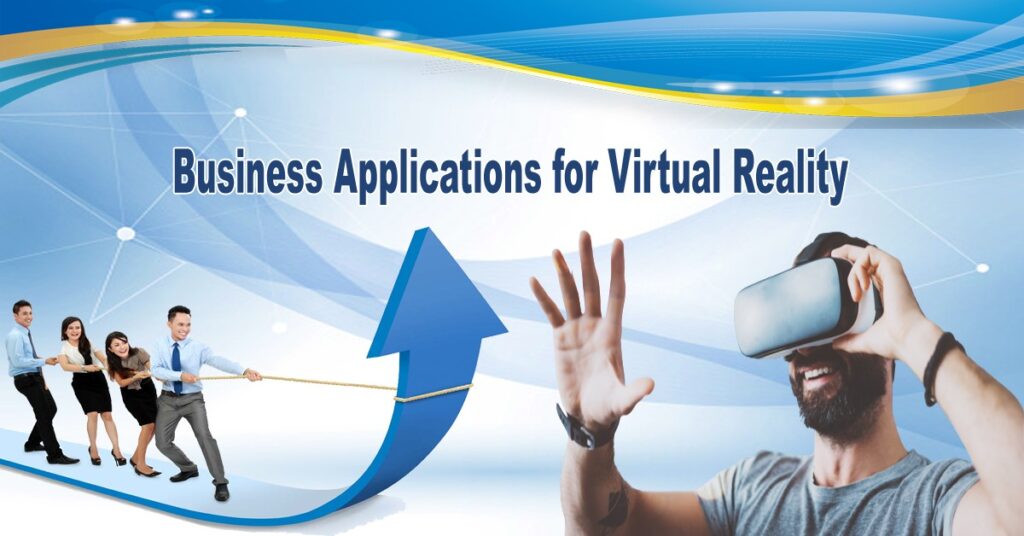Since its inception, virtual reality has been touted as the next big thing in computing. While VR has yet to reach the mainstream, there are a number of businesses that are already using it to transform their operations. By submerging a user in an environment, the brain is tricked into perceiving what they are seeing virtually as genuine. The application of VR can enhance the potential awareness and customers of different businesses. Here are the top 10 business applications for VR.
Table of Contents
How Different Business can Use Technologies:
Training and Simulation:
VR can be used to simulate real-world scenarios and environments, allowing employees to train in a safe environment without incurring any of the actual risks involved in the real world. The educational realm is rapidly recognizing the potential of virtual reality learning, as evidenced by Bank of America’s acquisition of 10,000 headsets and Walmart’s providing VR training to over one million workers. For example, doctors could use virtual reality to practice surgical procedures on lifelike 3D models before ever attempting them on a patient.
Utilizing the immersive power of VR training, learning retention levels skyrocket. PwC famously conducted a study on the efficacy of virtual reality for teaching soft skills and concluded that participants learned four times faster when using this method than traditional approaches.
Marketing and Advertising:
VR can be used to increase customer engagement and interaction with brands. Automakers such as Audi, BMW, and Nissan have all implemented virtual reality showrooms in order to let potential customers explore cars without ever leaving the comfort of their own homes. VR has also been leveraged for marketing campaigns involving product demonstrations or interactive experiences such as Pepsi’s “Summergram” campaign.
As virtual reality technology advances, universities are now turning to VR marketing to draw potential students. Princeton, Yale and Columbia have all taken advantage of this opportunity as a way for more people around the world to get an up-close look at their campus. With a virtual tour, they can experience being on campus just as if they were there in person.
Architecture and Construction:
VR is becoming popular in the architecture and construction industry as it allows designers to create 3D models of their designs. These models can be easily explored using a VR headset, allowing for greater collaboration between architects, engineers, and clients. This also makes it easier to spot problems or make changes during the design stage before construction even begins.
Read More:
Remote Collaboration and Meetings:
VR is being used to allow for remote collaboration and meetings among teams, no matter where they are located. Companies such as Facebook are using VR technology to create an immersive environment that allows users to collaborate on projects in a virtual office setting. This can help save time and money, as teams don’t have to physically be in the same location to work together.
Product Design and Development:
VR has been used in product design and development for many years, but with the advances in technology, it is becoming even more powerful. By utilizing virtual reality, companies like Ford can now identify issues and make revisions faster than ever before. This not only decreases the costs of production but accelerates the design process for their prototypes as well. With this technology, designers are able to test out concepts before anything physical is even created.
Healthcare:
Virtual reality has the potential to revolutionize healthcare by allowing physicians to practice complex procedures in an immersive environment and access detailed 3D models of patients for diagnosis. VR can also be used to create immersive therapeutic environments that can help patients suffering from conditions such as post-traumatic stress disorder (PTSD). VR has already been implemented in some hospitals with great success, allowing surgeons to practice complicated procedures without putting any lives at risk.
Entertainment and Gaming:
Virtual reality is not limited to business applications – it can be used for entertainment and gaming as well. VR-enabled games are becoming increasingly popular with gamers, immersing them in virtual 3D worlds that have been created to provide the ultimate interactive experience. Additionally, many amusement parks and museums are now turning to VR technology to create immersive experiences for their visitors, allowing them to explore different environments without leaving the comfort of their own home.
Education:
By leveraging virtual reality, educational institutions can craft engaging and immersive learning experiences for their students. From virtual field trips to immersive science lessons, VR can provide students with engaging and informative educational experiences that are not possible in the traditional classroom setting. The technology can also be used to teach soft skills such as public speaking, allowing students to practice and hone their communication abilities in a safe and engaging environment.
Real Estate:
VR technology is being used in the real estate industry to give potential buyers an immersive experience of properties they are interested in. Real estate agents can use VR to create virtual tours that allow buyers to explore their dream home before they even make an offer. This helps to streamline the process and make it easier for both buyers and sellers alike.
Virtual reality has revolutionized the real estate industry, allowing buyers to take virtual tours of potential listings and explore their options without any physical effort. Now you can access a virtually endless number of available homes with ease from the comfort of your own home before deciding which one is right for you.
Retail:
By incorporating VR technology, the retail industry is revolutionizing how customers to shop; now they can virtually explore a store’s stock and make purchases without ever having to leave their houses. Companies like Amazon are leveraging virtual reality to create immersive shopping experiences for customers, allowing them to virtually browse through product offerings before committing to a purchase. This helps to reduce the need for physical stores, increasing efficiency and saving costs for both retailers and customers.
VR also has the potential to revolutionize online shopping by allowing customers to virtually try on clothes or test out products before making a purchase. This can help reduce returns and increase customer satisfaction overall.
Travel:
Virtual reality is revolutionizing the way we travel. With VR, travelers can venture to any destination on Earth and explore it from a 360-degree perspective that feels truly authentic. From sampling local cuisines to experiencing tourist attractions firsthand, virtual reality gives them an unprecedented opportunity to make informed decisions about where they want their next vacation spot to be.
Additionally, airlines are leveraging VR technology to give customers a preview of their in-flight experience before they even book their flights. This helps to create an immersive and engaging booking experience that can be tailored to individual customers’ preferences.
Conclusion:
The potential for virtual reality is huge, and its applications are far-reaching. From entertainment and gaming to education, real estate, retail, and travel, VR is revolutionizing how we interact with the world around us. As technology continues to evolve and become more accessible, it will no doubt open up new opportunities for businesses and consumers alike.
By leveraging virtual reality, businesses can create immersive experiences that engage customers on a deeper level, increasing satisfaction and allowing them to make informed decisions about their purchases. With its limitless potential for innovation, virtual reality is sure to be a game changer in the world of technology.




